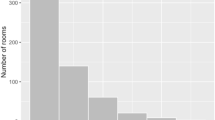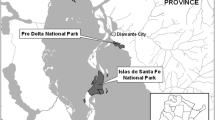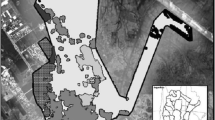Abstract
The Natal multimammate mouse (Mastomys natalensis) is the reservoir host of Lassa arenavirus, the etiological agent of Lassa fever in humans. Because there exists no vaccine for human use, rodent control and adjusting human behavior are currently considered to be the only options for Lassa fever control. In order to develop efficient rodent control programs, more information about the host’s ecology is needed. In this study, we investigated the spatial behavior of M. natalensis and other small rodents in two capture-mark-recapture and four dyed bait (Rhodamine B) experiments in Lassa fever-endemic villages in Upper Guinea. During the capture-mark-recapture studies, 23% of the recaptured M. natalensis moved between the houses and proximate fields. While M. natalensis was found over the entire study grid (2 ha), other rodent species (Praomys daltoni, Praomys rostratus, Lemniscomys striatus, Mus spp.) were mostly trapped in the surrounding fields. Distances between recapture occasions never exceeded 100 m for all rodent species. During the dyed bait experiments, 11% of M. natalensis and 41% of P. daltoni moved from the fields to houses. We conclude that commensal M. natalensis easily moves between houses and proximate fields in Guinea. We therefore consider occasional domestic rodent elimination to be an unsustainable approach to reduce Lassa virus transmission risk to humans, as M. natalensis is likely to reinvade houses quickly from fields in which rodents are not controlled. A combination of permanent rodent elimination with other control strategies (e.g., make houses rodent proof or attract predators) could be more effective for Lassa fever control, but must be further investigated.




Similar content being viewed by others
References
Asogun DA, Adomeh DI, Ehimuan J, Odia I, Hass M, Gabriel M, Olschlager S, Becker-Ziaja B, Folarin O, Phelan E, Ehiane PE, Ifeh VE, Uyigue EA, Oladapo YT, Muoebonam EB, Osunde O, Dongo A, Okokhere PO, Okogbenin SA, Momoh M, Alikah SO, Akhuemokhan OC, Imomeh P, Odike MAC, Gire S, Andersen K, Sabeti PC, Happi CT, Akpede GO, Günther S (2012) Molecular diagnostics for Lassa fever at irrua specialist teaching hospital, Nigeria: lessons learnt from two years of laboratory operation. PLoS Negl Trop Dis. https://doi.org/10.1371/journal.pntd.0001839
Bâ K, Kane M, Gauthier P, Granjon L (2012) Ecology of a typical West African Sudanian savannah rodent community. Afr J Ecol 51:447–455.
Bausch DG, Demby AH, Coulibaly M, Kanu J, Goba A, Bah A, Condé N, Wurtzel HL, Cavallaro KF, Lloyd E, Baldet FB, Cissé SD, Fofona D, Savané IK, Tolno RT, Mahy B, Wagoner KD, Ksiazek TG, Peters CJ, Rollin PE (2001) Lassa Fever in Guinea: I. Epidemiology of Human Disease and Clinical Observations DANIEL. Vector borne zoonotic Dis 1:269–281.
Bausch DG, Hadi CM, Khan SH, Lertora JJL (2010) Review of the Literature and Proposed Guidelines for the Use of Oral Ribavirin as Postexposure Prophylaxis for Lassa Fever. Clin Infect Dis 51:1435–1441. https://doi.org/10.1086/657315
Bonwitt J, Kelly AH, Ansumana R, Agbla S, Sahr F, Saez AM, Borchert M, Kock R, Fichet-Calvet E (2016) Rat-atouille: A Mixed Method Study to Characterize Rodent Hunting and Consumption in the Context of Lassa Fever. Ecohealth 13:234–247. https://doi.org/10.1007/s10393-016-1098-8
Bonwitt J, Sáez AM, Lamin J, Ansumana R, Dawson M, Buanie J, Lamin J, Sondufu D, Borchert M, Sahr F, Fichet-Calvet E, Brown H (2017) At home with mastomys and rattus: Human-rodent interactions and potential for primary transmission of lassa virus in domestic spaces. Am J Trop Med Hyg 96:935–943. https://doi.org/10.4269/ajtmh.16-0675
Borremans B, Hughes NK, Reijniers J, Sluydts V, Katakweba AAS, Mulungu LS, Sabuni CA, Makundi RH, Leirs H (2013) Happily together forever: temporal variation in spatial patterns and complete lack of territoriality in a promiscuous rodent. Popul Ecol 56:109–118. https://doi.org/10.1007/s10144-013-0393-2
Borremans B, Sluydts V, Makundi RH, Leirs H (2015) Evaluation of short-, mid- and long-term effects of toe clipping on a wild rodent. Wildl Res 42:143–148.
Carey DE, Kemp GE, Pinneo HAW, Addy RF, Fom ALMD, Stroh G, Henderson BE (1972) Lassa fever epidemiological aspects of the 1970 epidemic, Jos, Nigeria. Trans R Soc Trop Med Hyg 66:402–408.
Demby AH, Inapogui A, Kargbo K, Koninga J, Kourouma K, Kanu J, Coulibaly M, Wagoner KD, Ksiazek TG, Peters CJ, Rollin PE, Bausch DG (2001) Lassa Fever in Guinea: II. Distribution and prevalence of Lassa virus infection in small mammals. Vector borne zoonotic Dis 1:283–299.
Fichet-calvet E, Audenaert L, Barrie P, Verheyen E (2009) Diversity, dynamics and reproduction in a community of small mammals in Upper Guinea, with emphasis on pygmy mice ecology. Afr J Ecol 48:600–614.
Fichet-Calvet E, Becker-Ziaja B, Koivogui L, Günther S (2014) Lassa serology in natural populations of rodents and horizontal transmission. Vector Borne Zoonotic Dis 14:665–74. https://doi.org/10.1089/vbz.2013.1484
Fichet-Calvet E, Lecompte E, Koivogui L, Daffis S, ter Meulen J (2008) Reproductive characteristics of Mastomys natalensis and Lassa virus prevalence in Guinea, West Africa. Vector Borne Zoonotic Dis 8:41–8. https://doi.org/10.1089/vbz.2007.0118
Fichet-Calvet E, Lecompte E, Koivogui L, Soropogui B, Doré A, Kourouma F, Sylla O, Daffis S, Koulémou K, Ter Meulen J (2007) Fluctuation of abundance and Lassa virus prevalence in Mastomys natalensis in Guinea, West Africa. Vector Borne Zoonotic Dis 7:119–28. https://doi.org/10.1089/vbz.2006.0520
Fichet-Calvet E, Ölschläger S, Strecker T, Koivogui L, Becker-Ziaja B, Camara AB, Soropogui B, Magassouba N, Günther S (2016) Spatial and temporal evolution of Lassa virus in the natural host population in Upper Guinea. Sci Rep 1–6. https://doi.org/10.1038/srep21977
Fisher-Hoch SP, Hutwagner L, Brown B, McCormick JB (2000) Effective Vaccine for Lassa Fever. J Virol 74:6777–6783. https://doi.org/10.1128/jvi.74.15.6777-6783.2000
Fisher-Hoch SP, Tomori O, Nasidi A, Perez-Oronoz GI, Fakile Y, Hutwagner L, McCormick JB (1995) Review of cases of nosocomial Lassa fever in Nigeria: the high price of poor medical practice. BMJ 311:857–859. https://doi.org/10.1136/bmj.311.7009.857
Happold DCD (1977) A population study on small rodents in the tropical rain forest of Nigeria. LaTerre la Vie 31:385–458.
Hastie KM, Zandonatti MA, Kleinfelter LM, Heinrich ML, Rowland MM, Chandran K, Branco LM, Robinson JE, Garry RF, Saphire EO (2017) Structural basis for antibody-mediated neutralization of Lassa virus. Science 356:923–928.
Hess BH (2009) Mouse Ear Tattoo: A Quick and Easy Alternative to Ear Punches and Tags. J Am Assoc Lab Anim Sci 48:587–588.
Hoffmann A, Klingel H (2001) Spatial and temporal patterns in Mastomys cf. natalensis by radiotracking. In: African small mammals, Collection Colloques et seminaires, IRD Edition, Paris. Proceedings of the 8th International African Small Mammal Symposium, Paris 1999.
Hopkins AS, Whitetail-eagle JOE, Corneli AMYL, Person B, Ettestad PJ, Dimenna M, Norstog JON, Creswell J, Khan ALIS, Olson JG, Cavallaro KF, Bryan RT, Cheek JE, Begay B, Hoddenbach GA, Ksiazek TG, Mills JN (2002) Experimental Evaluation of Rodent Exclusion Methods Native American Community in New Mexico. Vector borne zoonotic Dis 2:61–68.
Jacob J, Jones D, Singleton G (2002) Retention of the bait marker Rhodamine B in wild house mice. Wildl Res 29:159–164.
Kingdon J, Happold D, Butynski T, Hoffmann M, Happold M, Kalina J (2013) The mammals of, hares and rabbits. Bloomsbury Publishing, London
Kronmann KC, Nimo-paintsil S, Obiri-danso K, Ampofo W, Fichet-calvet E (2013) Arenaviruses Detected in Pygmy Mice, Ghana. Emerg Infect Dis 19:1832–1835.
Labuschagne L, Swanepoel LH, Taylor PJ, Belmain SR, Keith M (2016) Are avian predators effective biological control agents for rodent pest management in agricultural systems? Biol Control 101:94–102. https://doi.org/10.1016/j.biocontrol.2016.07.003
Leirs H (1994) Population ecology of Mastomys natalensis (Smith, 1834). Implications for rodent control in Africa. Brussels
Leirs H, Verhagen R, Sabuni C, Mwanjambe P, Verheyen W (1997) Spatial patterns in Mastomys natalensis in Tanzania (Rodentia, Muridae). Belgian J Zool 127:29–38.
Lo Iacono G, Cunningham AA, Fichet-Calvet E, Garry RF, Grant DS, Khan SH, Leach M, Moses LM, Schieffelin JS, Shaffer JG, Webb CT, Wood JLN (2015) Using Modelling to Disentangle the Relative Contributions of Zoonotic and Anthroponotic Transmission: The Case of Lassa Fever. PLoS Negl Trop Dis. https://doi.org/10.1371/journal.pntd.0003398
Lukashevich IS, Clegg JCS, Sidibe K (1993) Lassa virus activity in Guinea: Distribution of human antiviral antibody defined using enzyme-linked immunosorbent assay with recombinant antigen. J Med Virol 40:210–217. https://doi.org/10.1002/jmv.1890400308
Mahlaba TAM, Monadjem A, McCleery R, Belmain SR (2017) Domestic cats and dogs create a landscape of fear for pest rodents around rural homesteads. PLoS One 12:1–9. https://doi.org/10.1371/journal.pone.0171593
Massawe AW, Mulungu LS, Makundi HR, Eiseb SJ, Kirsten F, Mahlaba T, Malebane P, Maltitz E Von, Monadjem A, Taylor P, Tutjavi V, Belmain SR (2011) Spatial and temporal population dynamics of rodents in three geographically different regions in Africa : Implication for ecologically-based. African Zool 46:393–405
Mccormick JB, Webb PA, Krebs JW, Johnson KM, Smith ES, Africa W (1987) A Prospective Study of the Epidemiology and Ecology of Lassa Fever carried out primarily in the eastern province of Sierra. J Infect Dis 155:437–444.
McCormick JB (1999) Lassa Fever, Emergence. Elsevier, Berlin Heidelberg
Mdangi M, Mulungu LS, Massawe AW, Eiseb SJ, Tutjavi V, Kirsten F, Mahlaba T, Malebane P, von Maltitz E, Monadjem A, Dlamini N, Makundi RH, Belmain SR (2013) Assessment of rodent damage to stored maize (Zea mays L.) on smallholder farms in Tanzania. Int J Pest Manag 59:55–62. https://doi.org/10.1080/09670874.2012.744495
Mills JN, Childs JE, Ksiazek TG, Peters CJ, Velleca WM (1995) Methods for trapping and sampling small mammals for virologic testing. Atlanta: Centers for disease control and prevention,
Mohr K, Leirs H, Katakweba A, Machang R (2007) Monitoring rodents movements with a biomarker around introduction and feeding foci in an urban environment in Tanzania. African Zool 42:294–298.
Monadjem A, Mahlaba T, Dlamnini N, Eiseb S, Belmain S, Mulungu L, Massawe AW, Makundi RH, Mohr K, Taylor PJ (2011) Impact of crop cycle on movement patterns of pest rodent species between fi elds and houses in Africa. Wildl Res 38:603–609.
Monadjem A, Perrin M (1998) The effect of supplementary food on the home range of the multimammate mouse Mastomys natalensis. South African J Wildl Res 28:1–3.
Monath TP (1987) Lassa Fever: New Issues Raised by Field Studies in West Africa. J Infect Dis 155:433–436. https://doi.org/10.1093/infdis/155.3.433
Mulungu LS, Borremans B, Ngowo V, Mdangi ME, Katakweba AS, Tesha P, Mrosso FP, Mchomvu M, Kilonzo BS (2015) Comparative study of movement patterns of Mastomys natalensis in irrigated rice and fallow fields in eastern Tanzania. Afr J Ecol 53:1–7. https://doi.org/10.1111/aje.12233
Olayemi A, Obadare A, Oyeyiola A, Fasogbon S, Igbokwe J, Igbahenah F, Ortsega D, Günther S, Verheyen E, Fichet-Calvet E (2017) Small mammal diversity and dynamics within Nigeria, with emphasis on reservoirs of the lassa virus. Syst Biodivers 2000:1–10. https://doi.org/10.1080/14772000.2017.1358220
R Core Team (2016) R: a language and environment for statistical 688 computing. R Foundation, Vienna
Rahelinirina S, Duplantier J, Ratsimba M, Ratovonjato J, Ramilijaona O, Papillon Y, Rahalison L (2009) Assessment of Rhodamine B for labelling the plague reservoir Rattus rattus in Madagascar. Afr J Ecol 48:662–666.
Singleton G, Belmain S, Brown P, Hardy B (2010) Rodent Outbreaks : Ecology and Impacts. Los Baños (Philippines): Inter- national Rice Research Institute.
Singleton GR, Hinds LA, Leirs H, Zhang Z (1999) Ecologically-based management of rodent pests-re-evaluating our approach to an old problem. Canberra, Australia: ACIAR.
Slade NA, Russell LA (1998) Distances as Indices to Movements and Home-Range Size From Trapping Records of Small Mammals. J Mammal 79:346–351. https://doi.org/10.2307/1382871
Sluydts V, Crespin L, Davis S, Lima M, Leirs H (2007) Survival and maturation rates of the African rodent, Mastomys natalensis: density-dependence and rainfall. Integr Zool 2:220–32. https://doi.org/10.1111/j.1749-4877.2007.00065.x
Stephenson E, Larson E, JW (1984) Effect of Environmental Factors on Aerosol-Induced Lassa Virus Infection. J Med Virol 14:295–303.
Swanepoel LH, Swanepoel CM, Brown PR, Eiseb SJ, Goodman SM, Keith M, Kirsten F, Leirs H, Mahlaba TAM, Makundi RH, Malebane P, Von Maltitz EF, Massawe AW, Monadjem A, Mulungu LS, Singleton GR, Taylor PJ, Soarimalala V, Belmain SR (2017) A systematic review of rodent pest research in Afro-Malagasy small-holder farming systems: Are we asking the right questions? PLoS One. https://doi.org/10.1371/journal.pone.0174554
Taylor PJ, Downs S, Monadjem A, Eiseb SJ, Mulungu LS, Massawe AW, Mahlaba TA, Kirsten F, Von Maltitz E, Malebane P, Makundi RH, Lamb J, Belmain SR (2012) Experimental treatment-control studies of ecologically based rodent management in Africa: Balancing conservation and pest management. Wildl Res 39:51–61. https://doi.org/10.1071/wr11111
Walker DH, Wulff H, Lange J V, Murphy FA (1975) Comparative pathology of Lassa virus infection in monkeys, guinea-pigs, and Mastomys natalensis. Bull World Health Organ 52:523–34.
World Health Organization (2016) Lassa fever. [online]. In: Available www.who.int/csr/disease/lassafever/en/ [Accessed 13 Jun. 2016].
Acknowledgements
Joachim Mariën is a research fellow of the Flemish Interuniversity Council (VLIR-UOS). We are particularly grateful to the field assistants of the Projet des Fièvres Hémorragiques en Guinée, who participated to the rodent sampling: Amara Camara, Mamadou Condé, Moussa Fofana, and Morlaye Sylla. We thanks Dr Mory Cherif, who facilitated the field work by his constant medical support toward the communities. We thank Dr Mami Cécé Gowara, Directeur Régional de la Santé, Dr N’Faly Bangoura, Directeur Préfectoral and Sayon Oulare who facilitated our work in the Faranah prefecture. The research was funded by the German Research Foundation (DFG FI 1781/1&2-1 and LE SPP 1596) and by the University of Antwerp and the Antwerp study centre for disease (ASCID) Grant Number GOA BOF FFB3567.
Author information
Authors and Affiliations
Corresponding author
Electronic supplementary material
Below is the link to the electronic supplementary material.
Rights and permissions
About this article
Cite this article
Mariën, J., Kourouma, F., Magassouba, N. et al. Movement Patterns of Small Rodents in Lassa Fever-Endemic Villages in Guinea. EcoHealth 15, 348–359 (2018). https://doi.org/10.1007/s10393-018-1331-8
Received:
Revised:
Accepted:
Published:
Issue Date:
DOI: https://doi.org/10.1007/s10393-018-1331-8




